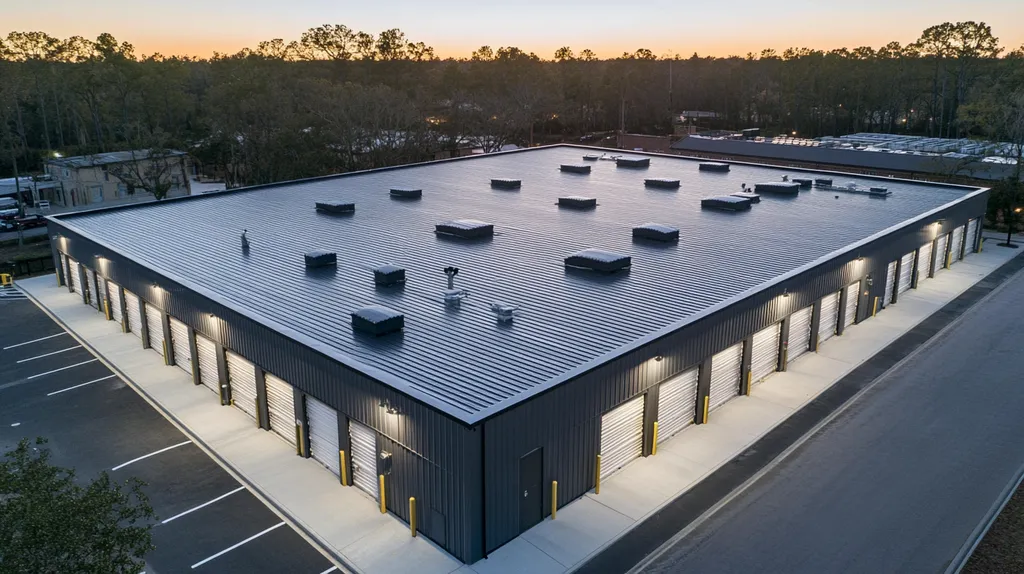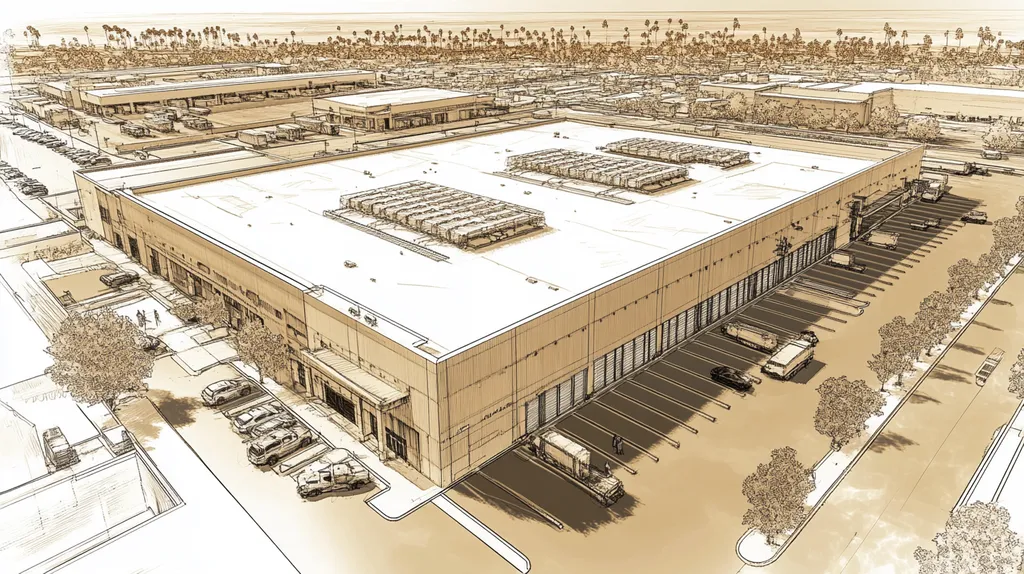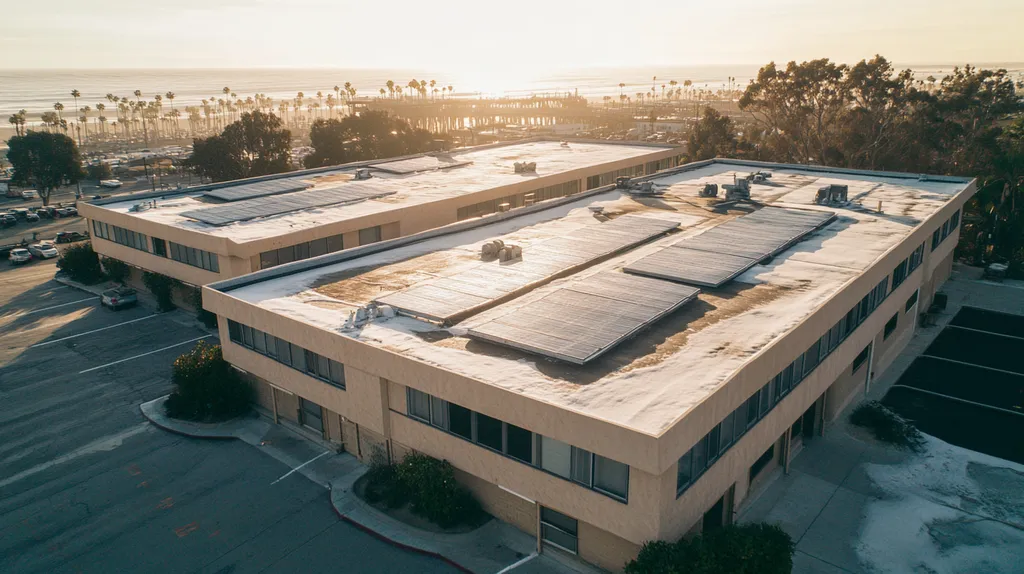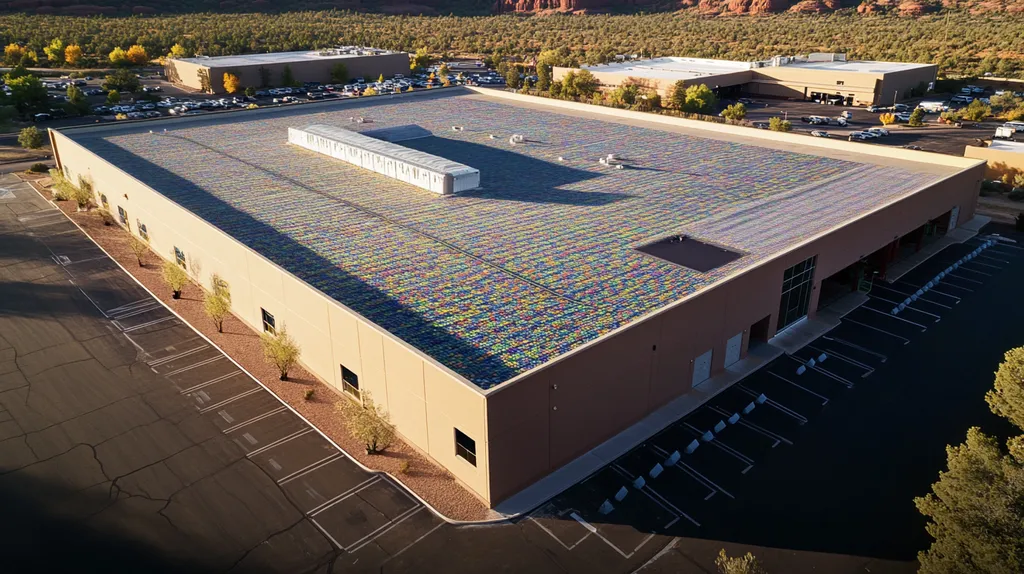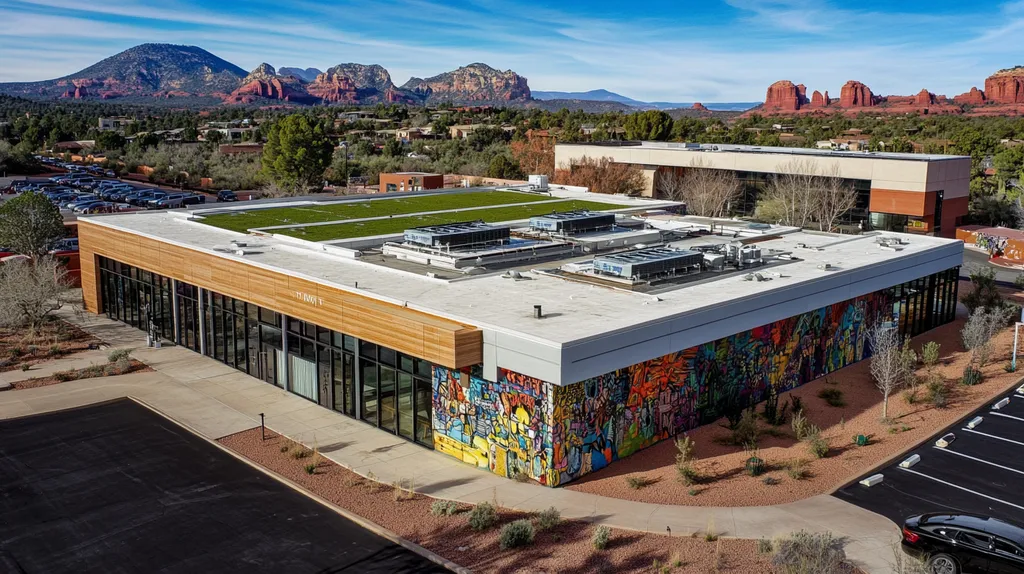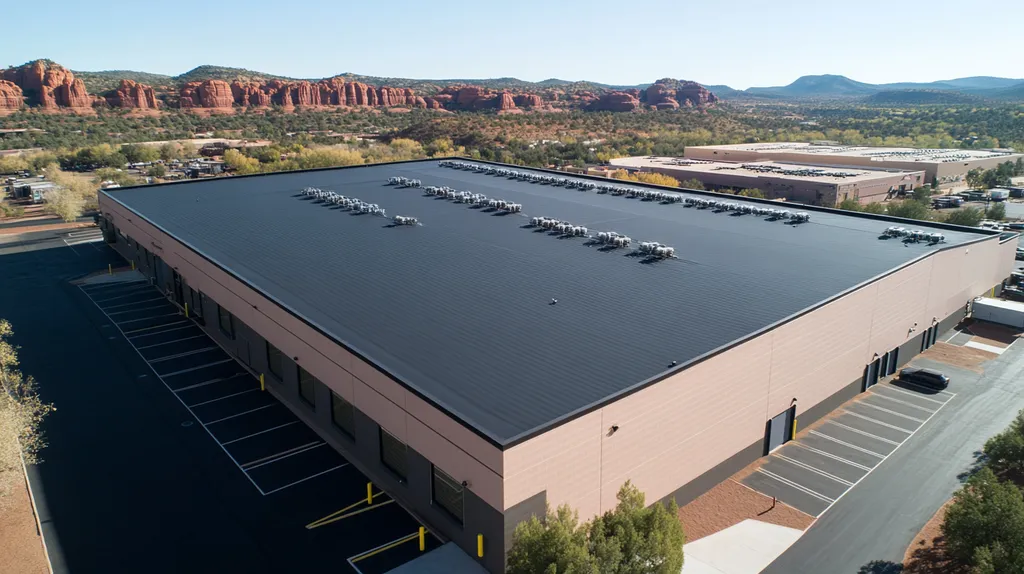Commercial roofs represent one of the most significant investments for property owners, with premature failure potentially costing hundreds of thousands in repairs and business disruption. Studies show that properly applied roof coatings can extend a roof’s lifespan by up to 25 years while reducing energy costs by as much as 35%.
Yet many building owners struggle to navigate the complex landscape of coating solutions, from material selection to application methods. Understanding the science behind roof coatings – and their proper implementation – has become crucial for protecting these valuable assets.
This comprehensive guide examines the latest coating technologies, system components, and maintenance strategies that empower property owners to maximize their roofing investments while promoting environmental sustainability.
SECTION 1: FUNDAMENTAL CONCEPTS
Every commercial building owner is faced with an essential challenge: how to effectively extend the life of their roof while controlling costs. Well-maintained roofs can last up to 30% longer, translating to substantial savings on replacement expenses. This section delves into the diverse types of commercial roof coatings, their remarkable properties, and critical environmental considerations, all designed to empower property owners to make educated decisions.
Types of Commercial Roof Coatings
Familiarity with the various roof coating types is vital for facility managers and property owners alike. The main categories include acrylic, silicone, and polyurethane coatings, each offering distinct attributes and advantages.
Acrylic coatings are a water-based option that excels in UV protection and reflectivity. These coatings are particularly effective at reducing energy costs by keeping buildings cooler during hot weather.
Silicone coatings boast impressive water resistance and durability, making them an excellent choice for roofs in rainy areas. Their flexibility ensures they can expand and contract with temperature changes without cracking.
Polyurethane coatings provide exceptional chemical resistance, making them perfect for industrial facilities that may encounter harsh contaminants and challenging weather conditions.
Choosing the appropriate coating requires understanding the specific needs of the building and its environment, highlighting the necessity of careful assessment.
Material Properties and Benefits
The effectiveness of roof coatings hinges on their material properties. High reflectivity coatings, for instance, can dramatically enhance energy efficiency by minimizing heat absorption from the sun.
Many coatings are also designed to promote waterproofing, which is essential for preventing leaks and water damage. Silicone, with its water-resistant qualities, offers critical protection for roofs in wet climates.
Furthermore, roof coatings defend against UV degradation, thereby extending the life of the foundational roofing material. This protection is crucial, as prolonged UV exposure can lead to severe wear over time.
Ultimately, the right coating delivers not just immediate benefits but also contributes to long-term savings by postponing the need for costly roof replacements. (source: Karnak Corporation)
Climate and Environmental Considerations
Climate is a decisive factor in selecting the right roofing solution. When choosing coatings, property owners must consider local weather patterns, including temperature variations and rainfall amounts.
For instance, areas with high temperatures could significantly benefit from reflective coatings that lower cooling costs, while regions that experience heavy rain may require moisture-resistant options like silicone.
Additionally, growing environmental regulations and sustainability aspirations should not be overlooked. Eco-friendly coatings with low volatile organic compounds (VOCs) are increasingly important for meeting compliance standards and enhancing indoor air quality.
Factoring in climate and environmental elements not only ensures regulatory alignment but also boosts the performance and longevity of the roofing system.
SECTION 2: SYSTEM COMPONENTS
Ensuring the integrity of a commercial roof is not just a matter of aesthetics; it’s essential for avoiding costly repairs and keeping business operations running smoothly. In fact, roofs can consume up to 40% of a building’s maintenance budget, highlighting the need for effective solutions. By grasping the different coating options and their components, property owners can significantly extend the lifespan of their roofs, safeguard their investments, and mitigate unforeseen expenses. This section demystifies the key materials and elements that form a comprehensive roofing coating system.
Coating Materials: Silicone, Acrylic, Polyurethane
Choosing the appropriate coating material is crucial for ensuring both durability and long-lasting performance. Silicone coatings stand out for their exceptional water resistance and UV protection, making them a top choice for flat roofs in wet climates. On the other hand, acrylic coatings are versatile and easy to apply, offering good weather resistance without breaking the bank.
For robustness, polyurethane coatings are unmatched; they can handle foot traffic and resist mechanical damage effectively. It’s vital to understand the unique strengths and weaknesses of each material to align them with the specific conditions of your roof. Factors such as temperature fluctuations and moisture levels will influence performance and adhesion.
While initial costs are important, property owners should also consider the long-term financial impact of their coating decisions. Choosing an unsuitable coating may accelerate wear and lead to more expensive repairs in the future. Knowledge of these factors is essential to make informed roofing choices that will extend the lifespan and efficiency of the roof.
With a growing emphasis on sustainable practices, understanding the distinct qualities of each coating type also supports eco-friendly goals. Making informed selections can align both functional needs and environmental aspirations.
Roof Substrate Compatibility
The roof substrate—the surface beneath the coating—is a critical element that can dramatically affect the performance of the roofing system. Different substrates, including metal, single-ply membranes, and modified bitumen, each have unique requirements when it comes to coatings. A mismatch between the substrate and the chosen coating can lead to adhesion issues or even void warranties, resulting in unexpected expenses.
For instance, silicone coatings are known to bond effectively with metal roofs but may not perform well on all types of single-ply membranes. Understanding these compatibility nuances is key to avoiding costly mistakes that could compromise the roof’s integrity. Ensuring that the coating and substrate are matched guarantees optimal performance over time.
It’s also essential to evaluate the substrate’s condition prior to applying any coatings. Regular inspections can reveal underlying problems that need addressing before application, preventing leaks and structural damage further down the line.
Ultimately, compatibility assessments should be conducted by experienced professionals. This crucial step helps to guarantee that the coating will perform effectively, maximizing both the longevity and efficiency of the roof.
Additional System Components: Primers, Sealants
Beyond the primary coating materials, primers and sealants play indispensable roles in crafting a successful roofing system. Primers are often necessary to enhance adhesion, particularly on substrates that resist bonding. By applying a primer, property owners can ensure that the coating adheres properly, which is vital for maintaining system longevity.
Sealants provide an additional layer of protection by filling seams, joints, and any vulnerable spots. High-quality sealants are crucial in preventing water intrusion, significantly extending the roof’s lifespan. Even the best coatings can underperform without these integral components.
Selecting compatible primers and sealants ensures a cohesive system. Property owners should be cautious against cutting costs with inferior alternatives, as this can undermine overall effectiveness. Choosing components from reputable manufacturers can have a profound impact on the roof’s performance and durability.
Moreover, these additional elements can be tailored to meet specific building requirements or environmental conditions. A thorough understanding of the entire system—including primers and sealants—equips property owners to make savvy decisions that yield optimal results for roof longevity.
SECTION 3: IMPLEMENTATION METHODS
Effective roof coating implementation is non-negotiable for safeguarding the longevity of commercial roofs. Neglecting proper maintenance leads to severe structural damage, which can result in repair costs soaring into the thousands. Studies indicate that a skillfully applied roof coating can extend a roof’s life by as much as 20 years. It is crucial for property owners and facility managers to understand professional installation techniques, surface preparation, and application specifications to maximize their roofing investment.
Professional Installation Techniques
Hiring qualified professionals for roof coating applications is essential for achieving long-lasting results. Experienced roofers bring a wealth of knowledge, ensuring that industry standards and manufacturer specifications are met. When installation is done poorly, it can undermine the protective benefits of the coating, leading to leaks and surface deterioration.
Professional installers use advanced tools and techniques tailored to the specific roofing materials involved. This includes employing spray guns, rollers, and brushes to ensure the coating is evenly distributed. Each method is selected based on the roof’s condition and type, optimizing the application process.
Additionally, professional installation typically includes a warranty that protects against issues arising from improper application. Such warranties are not just a safety net; they guarantee that the investment in the coating will deliver long-term benefits.
In summary, choosing experienced professionals sets the stage for a successful coating application, ultimately enhancing roof longevity and minimizing future maintenance needs.
Surface Preparation and Cleaning
A critical step before applying any coating is thorough surface preparation. An unprepared or dirty surface can severely impact adhesion, leading to premature coating failure. Proper cleaning is essential to eliminate debris, dirt, and contaminants that could hinder performance.
Common preparation methods include pressure washing, scraping, and using suitable chemical cleaners based on the roof material. Each method should be selected according to the specific contaminants present for optimal results.
After cleaning, it’s essential to inspect the roof for any damage, such as cracks or blisters, and address them promptly. This proactive approach ensures a better bond between the coating and the roof, enhancing durability.
Moreover, effective surface preparation prevents moisture retention and issues that could compromise the integrity of the coating long-term. By prioritizing cleanliness and repairs, property owners can significantly extend the lifespan of the roof coating.
Application Thickness and Uniformity
The thickness and uniformity of the coating application are pivotal for achieving optimal performance. A too-thin application may lead to inadequate protection, while a layer that is too thick can result in cracks and peeling. Adhering to manufacturer guidelines for application thickness is essential for the best results.
Uniform application is also crucial—ensuring that all areas receive consistent coverage protects against weak points where moisture can infiltrate and cause significant problems later. Professionals often use gauges to measure thickness, ensuring every part of the roof receives equal protection.
It’s important to monitor environmental conditions during application, as factors like temperature and humidity can greatly impact the coating’s curing and effectiveness. Ensuring these conditions are suitable contributes to the overall success of the roofing system.
Ultimately, focusing on the correct application thickness and uniformity plays a vital role in enhancing performance and extending the roof’s lifespan, providing lasting value for property owners.
SECTION 4: MAINTENANCE REQUIREMENTS
Neglecting proper maintenance of commercial roof coatings can drastically shorten their lifespan, leading to costly repairs and early replacements. Research indicates that routine maintenance can extend a roof’s life by up to 50%. Critical activities such as regular inspections, thorough cleaning, and proactive measures against UV damage are essential for ensuring these systems perform at their best and shield the underlying structure effectively.
Regular Inspection and Monitoring
Regular inspections are crucial for maintaining the integrity of commercial roof coatings. Property owners should aim for at least two inspections each year, along with additional assessments after severe weather. This proactive approach allows for the early identification of wear and tear, enabling timely interventions that can preserve the roof’s functionality.
During inspections, trained professionals should inspect the coating for any signs of damage, such as cracks, blisters, or peeling. These indicators may signify underlying issues that threaten the roof’s performance.
Additionally, monitoring the drainage systems is vital. Clogged drains can create water pooling, detrimental to both the coating and the underlying roof structure. Keeping these systems clear is an important aspect of effective roof management.
Early detection through routine inspections can prevent extensive damage and significant repair costs down the line. Each inspection plays a role in assuring the reliability of the roofing system and ensuring a sound investment in coatings yields long-term benefits.
Cleaning and Repair Procedures
Regular cleaning is a critical yet often overlooked component of roof maintenance. It prevents debris accumulation, which can trap moisture and encourage mold growth. Property owners should incorporate cleaning as a regular part of their maintenance schedules.
Effective cleaning methods include the use of pressure washers or soft wash systems that can remove dirt and contaminants without risking damage to the coating. Always follow manufacturer guidelines to prevent unintended harm.
In tandem with cleaning, addressing any identified issues promptly is vital. Small cracks or separations can escalate if ignored, potentially leading to coating failure that could cost property owners more in the long run.
To ensure effective repairs, it’s important to use materials that are compatible with the existing coating. This guarantees a seamless repair that upholds both the performance and aesthetic of the roofing system.
Preventative Measures Against UV Damage
UV damage presents a significant threat to commercial roof coatings, as prolonged sun exposure can lead to brittleness and deterioration of protective properties. Implementing preventative measures can significantly mitigate this risk.
One practical strategy is applying a reflective coating. These coatings can lower UV exposure while enhancing energy efficiency by keeping buildings cooler. Property owners should evaluate the necessity of these options based on their location and climate conditions.
Regular monitoring during inspections is also crucial to detect UV damage. If any discoloration or chalking becomes evident, further protective measures may be warranted.
By prioritizing UV protection within a maintenance plan, property owners can significantly extend the life of their roofing systems, ensuring their lasting effectiveness and the safety of the building over time.
SECTION 5: PERFORMANCE METRICS
Evaluating the performance metrics of roofing coatings is essential for commercial and industrial property owners. These metrics have substantial implications for long-term sustainability and financial efficiency. Research indicates that selecting appropriate coatings can extend a roof’s lifespan by 10 to 20 years. This section will examine lifespan expectations, energy cost savings, and enhanced leak resistance—key factors that drive smart roofing decisions.
Lifespan and Durability Expectations
The right roof coating can dramatically improve the lifespan of a commercial roof. By acting as a shield against UV rays, heavy rain, and extreme temperatures, these coatings can extend a roof’s life by as much as 50% or more when properly applied.
Most reliable coatings come with warranties lasting up to 15 years, providing assurance to property owners. This durability leads to fewer maintenance requirements, saving time and money throughout the years. Moreover, coatings can breathe new life into aging roofs, decreasing the likelihood of needing complete replacements.
Studies show that well-maintained commercial roofs can last over 30 years, while roofs without coatings often fail significantly sooner. Such longevity aligns with asset management goals, safeguarding investments in commercial properties. Therefore, property owners should carefully evaluate coating options based on expected lifespan to maximize the value of their roofing systems.
Energy Efficiency and Cost Savings
Energy efficiency is crucial for modern facilities, as heating and cooling costs constitute a significant part of operational budgets. Coatings with reflective properties can greatly lower a roof’s surface temperature, leading to reduced energy consumption for climate control.
Research reveals that reflective coatings can cut cooling costs by up to 30%, leading to substantial savings over time, particularly in hot climates. Additionally, this energy efficiency can open doors to tax benefits and incentives.
By enhancing energy performance, property owners also extend the lifespan of HVAC systems. Reduced stress on these systems translates into lower operational costs over time, promoting a more sustainable facility.
Investing in energy-efficient coatings not only leads to cost savings but also boosts a property’s green credentials, enhancing its competitiveness in today’s market.
Leak Resistance and Water Protection
Leak resistance is vital for maintaining the integrity of any commercial roof. High-quality coatings create a seamless, waterproof barrier that prevents water infiltration, which can lead to mold and significant structural damage.
Property owners frequently report a notable decrease in leaks after applying these coatings. Often, they adhere directly to existing roofing surfaces, filling in cracks and establishing a solid defense against moisture. This proactive approach can save property owners from costly repairs and safeguard valuable assets.
Moreover, these coatings are designed to withstand the effects of thermal expansion and contraction. This flexibility is essential in varying weather conditions, reducing the risk of damage that can lead to leaks.
Ensuring effective water protection supports a building’s longevity, benefiting both operating budgets and tenant satisfaction. A well-maintained roof, reinforced with the right coatings, is a key consideration within any property management strategy.
SECTION 5: PERFORMANCE METRICS
Evaluating the performance metrics of roofing coatings is crucial for commercial and industrial property owners. A well-selected coating can significantly impact long-term sustainability and financial efficiency. Research indicates that the right coatings can extend a roof’s lifespan by 10 to 20 years. This section delves into lifespan expectations, energy savings, and enhanced leak resistance—key drivers of smart roofing decisions.
Lifespan and Durability Expectations
Applying the right roof coating can dramatically enhance a roof’s lifespan. Coatings act as barriers against UV rays, heavy rain, and temperature extremes, allowing roofs to last up to 50% longer when installed correctly.
Many high-quality coatings come with warranties lasting up to 15 years, assuring property owners of their durability. This resilience leads to reduced maintenance needs, translating into significant time and cost savings over the years. Furthermore, coatings can rejuvenate aging roofs, postponing the need for full replacements.
Studies demonstrate that well-maintained commercial roofs can exceed 30 years in lifespan, compared to those without coatings, which often fail much earlier. Such longevity not only protects investments but also aligns with asset management strategies that prioritize sustainable real estate solutions.
Energy Efficiency and Cost Savings
Energy efficiency is a pressing concern for modern facilities, as heating and cooling expenses can account for a substantial portion of operational budgets. Roof coatings with reflective properties can significantly reduce surface temperatures, leading to lower energy consumption.
Research shows that reflective coatings can decrease cooling costs by up to 30%, providing substantial savings over time, especially in hot climates. Additionally, this improved energy performance can unlock potential tax benefits and incentives.
By boosting energy efficiency, property owners can also extend the lifespan of HVAC systems. Reduced strain on these systems results in lower operational costs in the long run, contributing to a more sustainable and cost-effective facility.
Incorporating energy-efficient coatings not only delivers financial savings but also enhances a property’s green credentials, making it more competitive in today’s environmentally-conscious market.
Leak Resistance and Water Protection
Leak resistance is essential for preserving the integrity of any commercial roof. High-quality coatings create a seamless, waterproof layer that effectively prevents water infiltration, crucial for avoiding mold and structural issues.
Property owners often report decreased leak occurrences after applying these robust coatings. Designed to adhere directly to existing roofs, they seal cracks and create a unified protective barrier. This proactive approach can spare owners from costly repairs, safeguarding essential assets.
Additionally, coatings are engineered to endure thermal expansion and contraction. This flexibility is vital as weather conditions change, significantly reducing the risk of damage that typically leads to leaks.
By ensuring effective water protection, property owners can enhance a building’s longevity, leading to benefits for both operating costs and tenant satisfaction. A well-maintained roof fortified with the right coatings is a cornerstone of an effective property management strategy.
The Bottom Line
With commercial roof replacement costs averaging $250,000-500,000 for a typical 20,000 square foot building, the stakes for proper coating implementation have never been higher.
Studies consistently show that well-maintained coating systems can extend roof life by 15-25 years while reducing energy costs up to 35% through enhanced reflectivity and insulation.
Property owners who implement comprehensive coating strategies – from proper material selection to regular maintenance – protect not just their buildings, but their bottom lines.
As environmental regulations tighten and energy costs continue rising, coating solutions represent a critical investment in both sustainability and asset protection.
The future of commercial roofing lies not in frequent replacement, but in strategic coating systems that maximize longevity while minimizing environmental impact.
FREQUENTLY ASKED QUESTIONS
Q. How can coatings help extend the life of a commercial roof?
A. Well-chosen coatings can significantly protect roofs from UV rays, moisture, and temperature extremes. By applying the right coatings, roof systems can last up to 30% longer. This longevity saves property owners on costly replacements while ensuring the building remains secure and efficient.
Q. What types of industrial roof coatings are available?
A. There are various coating types, including silicone, acrylic, and polyurethane. Each type has unique benefits, like UV resistance or flexibility, making them suitable for different roof conditions. It’s essential to assess the specific needs of your building and environment to select the best solution.
Q. Why is professional installation important for commercial roofs?
A. Professional installation ensures coatings are applied correctly, maximizing their benefits. Skilled roofers understand manufacturer guidelines and use proper techniques, preventing future issues like leaks. This expertise typically includes a warranty that guarantees your coating investment.
Q. How often should I inspect my commercial roof?
A. It’s advisable to inspect your commercial roof at least twice a year. Inspections after severe weather are also crucial to identify any damage or wear early. Routine checks allow for timely maintenance, prolonging roof life and preventing costly repairs.
Q. What performance metrics should I evaluate for my commercial roof?
A. Key metrics include lifespan, energy efficiency, and leak resistance. Properly selected coatings can extend lifespan significantly, while reflective coatings can reduce energy costs. Evaluating these factors means making informed roofing decisions that support your long-term financial goals.
Q. How can I protect my commercial roof from UV damage?
A. Applying reflective coatings can effectively mitigate UV damage. These coatings not only shield the roof but also reduce cooling costs. Regular monitoring during inspections for signs of UV deterioration helps in planning timely interventions.
Q. What are the risks of not maintaining my commercial roof?
A. Neglecting roof maintenance can lead to premature coating failure, resulting in significant repair costs. Without regular inspections, issues like leaks and structural damage may go unnoticed, ultimately decreasing the roof’s lifespan and your property’s value.

